The Top Ten Extinct Animals
Life is a gradual process of evolution and extinction. Every species on earth forms an important part of the ecosystem. The disappearance of a species can lead to an ecological imbalance. Sometimes we find species we thought were extinct to be alive. But sadly that is too often not the case. Today we discuss the top ten extinct animals.
Several causes are responsible for the extinction of animals and birds. Natural as well as man-made factors together contributed in causing many animals and birds to become extinct. Habitat loss, rapid growth of human population, commercial exploitation of animals, pollution, diseases, introduction of non-native species of animals, and climate change are the factors responsible for extinction of animals and birds.
Dodo: It was discovered in 1505 by Portuguese explorers on the island of Mauritius. This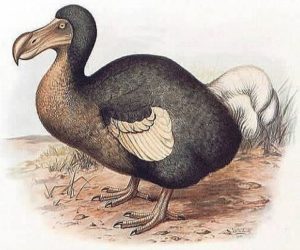 flightless bird weighed about fifty pounds. Introduction of non-native animals such as pigs, monkeys, and rats endangered their existence. The dodo’s eggs were fed upon by these introduced creatures. The last dodo was sighted in 1681.
flightless bird weighed about fifty pounds. Introduction of non-native animals such as pigs, monkeys, and rats endangered their existence. The dodo’s eggs were fed upon by these introduced creatures. The last dodo was sighted in 1681.
The dodo bird is perhaps the most famous extinct animal. This flightless bird lived on the island of Mauritius in the Indian Ocean until it was hunted to extinction in the late 17th century.
Carolina Parakeet: This extinct bird was once abundantly found in large colonies in the swamps of Cypress across south Atlantic and Gulf States. They were slaughtered as pets, and were widely hunted for their feathers. Sighting of a small flock of this bird in the wild was last reported in 1920.
Bachman’s Warbler: This species of bird has recently become extinct. It lived in the forested swamps of the eastern United States. It has not been sighted since the early 1960s, and is listed as endangered animals.
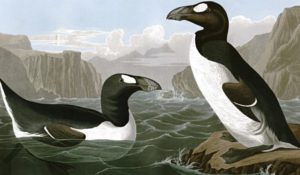 The Great Auk: The great auk was a flightless bird that lived in the North Atlantic. It was hunted for its feathers, meat, and oil, and went extinct in the mid-19th century.
The Great Auk: The great auk was a flightless bird that lived in the North Atlantic. It was hunted for its feathers, meat, and oil, and went extinct in the mid-19th century.
It is also known as Garefowl. It was widely found across the North Atlantic region ranging from Ireland to Greenland to almost to the Arctic Circle. It became extinct by mid 19th century as the sailors fed themselves on the eggs of this bird.
Labrador Duck: It was found on the coasts of Quebec in Canada. It became extinct in 1870s.
Quagga: The quagga was a subspecies of zebra that lived in South Africa. It was hunted to extinction in the late 19th century.
They were native of the Karoo plains and Southern Free State of South Africa. A 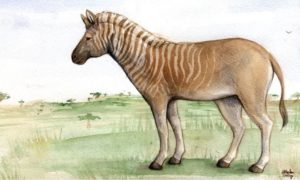 large-scale hunting of this animal by the ranchers in the mid 19th century caused rapid decline in their numbers. The last quagga was reported dead in 1883 in an Amsterdam zoo.
large-scale hunting of this animal by the ranchers in the mid 19th century caused rapid decline in their numbers. The last quagga was reported dead in 1883 in an Amsterdam zoo.
Caspian Tiger: It is also known as the Persian Tiger. Once found throughout the Central and southern Asia, this animal was hunted for its hides. It was often killed by the villagers to protect their livestock when attacked. It was last sighted in 1957.
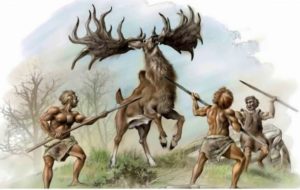 Irish Deer: The Irish elk, also known as the giant deer, was one of the largest deer species to ever exist. It went extinct around 7,700 years ago, likely due to hunting and climate change.
Irish Deer: The Irish elk, also known as the giant deer, was one of the largest deer species to ever exist. It went extinct around 7,700 years ago, likely due to hunting and climate change.
The Irish elk or the Giant Deer was the largest deer that ever lived on earth. It was found in Europe, and is believed to have lived about 10,000 years ago.
Tasmanian Wolf: The Tasmanian tiger, also known as the thylacine or wolf, was once native to Australia and Tasmania. It became extinct in the early 20th century due to hunting and habitat destruction.
It became extinct about fifty years ago. It was not a wolf, but a carnivorous marsupial considered to be a distant relative of wombats and kangaroos.
Therefore, extinct animals and birds, which 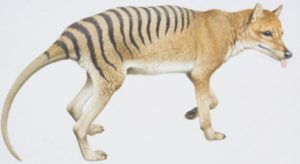 once formed an important part of the ecosystem, are no more alive. Human destructive activities combined with natural forces made their existence impossible. Climate change and the inability to adapt to a new environment caused many animals and birds to become extinct.
once formed an important part of the ecosystem, are no more alive. Human destructive activities combined with natural forces made their existence impossible. Climate change and the inability to adapt to a new environment caused many animals and birds to become extinct.
In conclusion, these are just a few examples of the many fascinating animals that have gone extinct throughout history. While it is unfortunate that we will never be able to see these creatures in person, their stories can teach us important lessons about the impact that humans can have on the natural world. It is up to us to ensure that we do not repeat the mistakes of the past and that we work to preserve the biodiversity of our planet for future generations.